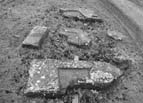Select a site alphabetically from the choices shown in the box below. Alternatively, browse sculptural examples using the Forward/Back buttons.
Chapters for this volume, along with copies of original in-text images, are available here.
Object type: Socket-stone(s), in three fragments ('Headless cross')
Measurements:
(a): L. 172 cm (68 in); W. 90 cm (35.5 in); D. 23 cm (9 in); socket 58 x 55 cm (23 x 21 in)
(b): L. 86 cm (34 in); W. 83 cm (32.5 in); D. 23 cm (9 in); socket 50 x 44 cm (19.5 x 17.5 in)
(c): L. 119 cm (47 in); W. 77 cm (30.5 in); D. 23 cm (9 in); socket 55 x 55 cm (21 x 21 in)
Stone type: Not examined
Plate numbers in printed volume: Ill. 383
Corpus volume reference: Vol 9 p. 142
(There may be more views or larger images available for this item. Click on the thumbnail image to view.)
The three stones were all roughly squared and each carries a shallow recess. The display notice suggests that they were set inside each other to form a stepped cross-base; they certainly do not fit together to form a large platform with central recess.
Appendix A item (stones dating from Saxo-Norman overlap period or of uncertain date)
The stones came from a site close to the boundary of Leighton township in an area where several fields are named "Headless Cross" or variants thereon (Dodgson 1972, 224; Rumble 2006, 30–1): Evans (1994) noted that the name occurs in various sixteenth- and seventeenth-century documents, notably a Manor Bounds description of Leighton (1581) and the Cheshire Court Rolls of 1613. Peter France (in litt., February 2006) records that the rectangular area, from which it is assumed that the stones originally came, pre-dated the boundary bank 'bearing a hedge with a count of nine or ten species'. Stepped bases to pre-Norman crosses occur in this region at Halton St Wilfrid 10 and Walton on the Hill 3 (Ills. 501–2, 657–8), and there is documentary evidence for the function of crosses as boundary markers (see Chapter V, p. 36). Dating of these particular stones to the pre-Norman period, however, is dependent upon the accuracy of chronologies based on hedgerow species counting.



